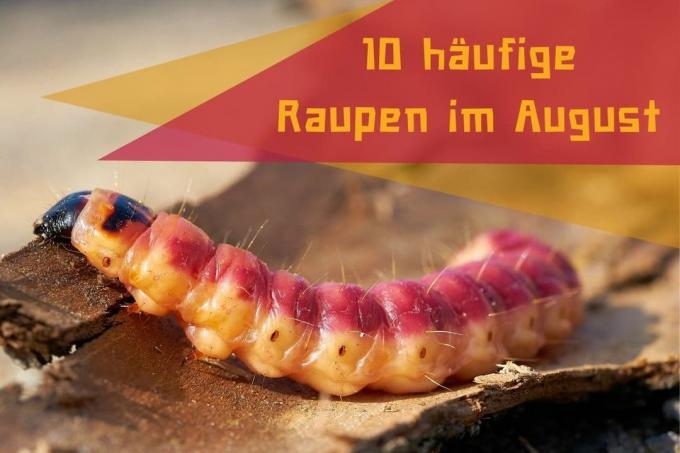
table of contents
- Moth
- Types from A - J
- Types from L - Z
- Butterflies
- Types from A - K
- Types from L - Z
- frequently asked Questions
In August there are caterpillars of butterfly species that produce a spring and autumn generation. During this time, moth caterpillars and moth caterpillars can be observed. Many overwinter and only hatch in the coming spring.
In a nutshell
- caterpillars of moths and butterflies appear in August
- Species that produce two or more generations per year are particularly common
- One-generation butterfly caterpillars can appear in warmer regions in August
- few species are considered to be culture pests
Moth
Typical for this group of butterflies is their activity in the protection of darkness. Because their wings are perfectly camouflaged, the insects do not fold up when they are at rest. Your body appears short and therefore thickened. The antennae on the head are pointed, feathered or combed. Moth caterpillars try to scare off predators with bright warning colors.
Types from A - J
Evening peacock butterfly

- scientific name: Smerinthus ocellata
- Occurrence: often in damp forests and less often in gardens
- Forage crops: willow, poplar and cultivated apple
- Hatching time: in the following year from mid-May to July
- Generations: one, rarely two per year
- Appearance: blue or yellow green with fine white dots and yellow side stripes
- Special feature: the top of the body is significantly lighter than the underside
- Size: up to 80 millimeters long
Note: The caterpillars, which can often be seen in August, can easily be confused with those of linden or poplar swarms at first glance. The most striking distinguishing feature is the blue horn at the rear end of the body.
Agate owl
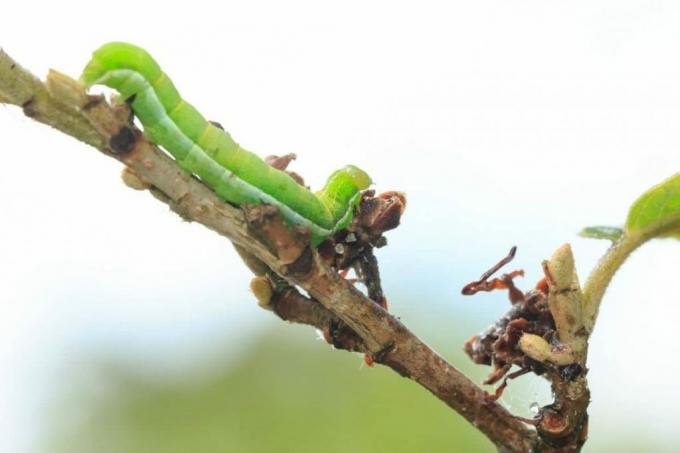
- scientific name: Phlogophora meticulosa
- Occurrence: in various open landscapes
- Forage crops: sorrel, nettle, willow, chrysanthemum
- Hatching time: after overwintering in May to July
- Generations: two in one year
- Appearance: variable from green to orange-brown to dark brown with a fine openwork line on the back
Types from L - Z
Linden hawk

- scientific name: Mimas tiliae
- Occurrence: distributed throughout Germany near deciduous forests
- Forage crops: mainly Linden tree, but also cherry and birch or young fruit trees
- Hatching time: after wintering between late May and early July
- Generations: one, in southern regions two per year
- Appearance: green to blue-gray with a dark anal horn, later dark yellow diagonal stripes
- Size: 55 to 65 millimeters
- Risk of confusion: evening peacock butterfly and poplar hawkmoth
Willow Borer

- scientific name: Cossus cossus
- Occurrence: in alluvial forests and settlements
- Forage plants: eat their way into the wood of willows, poplars and fruit trees
- Hatching time: after two to four wintering periods between May and August
- Generations: one a year
- Appearance: yellow with dark red back and isolated white hairs
- Size: up to 100 millimeters
Cinnamon bear
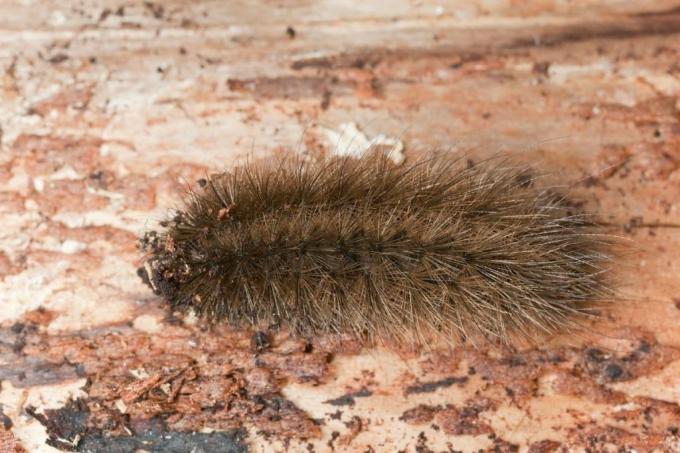
- scientific name: Phragmatobia fuliginosa
- Occurrence: in meadows, pastures and wasteland, in forests
- Forage plants: blackberries, blackthorn, meadowsweet, ribwort, dandelion
- Hatching time: after overwintering from the beginning of April
- Generations: two generations a year
- Appearance: black-gray with light yellow vertical stripes on the back and thick tufts of hair
- Size: up to 35 millimeters
Butterflies
These moths are mostly active in daylight or at dusk. Their folded shape at rest is typical. Its long and narrow body has two antennae on the head that end with a club-shaped thickening. Butterfly caterpillars are usually less conspicuously colored than the larvae of night moths.
Types from A - K
Large cabbage white butterfly

- scientific name: Pieris brassicae
- Occurrence: throughout the country in meadows with nectar-rich flowering plants
- Forage crops: various types of cabbage and cruciferous plants
- Hatching time: after about 14 days
- Generations: two a year
- Appearance: greenish yellow with irregularly shaped dark spots and white bristles
- Size: up to 40 millimeters
Little fox

- scientific name: Nymphalis urticae
- Occurrence: throughout Germany in different habitats
- Forage plants: nettle
- Hatching time: after 30 to 60 days
- Generations: two a year in warmer regions
- Appearance: black with fine white spots and two interrupted yellow side lines
- Size: about 30 millimeters
Little cabbage white butterfly
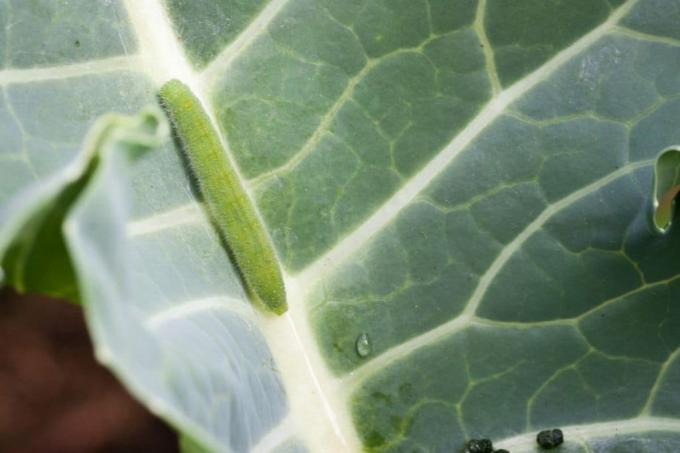
- scientific name: Pieris rapae
- Occurrence: extensive in different habitats
- Forage crops: cabbage and vegetables, nasturtiums, rapeseed
- Hatching time: after winter from March
- Generations: up to four a year
- Appearance: dull or light green with yellow stripes and white spots and thick hair
- Size: up to 25 millimeters
Types from L - Z
Land map
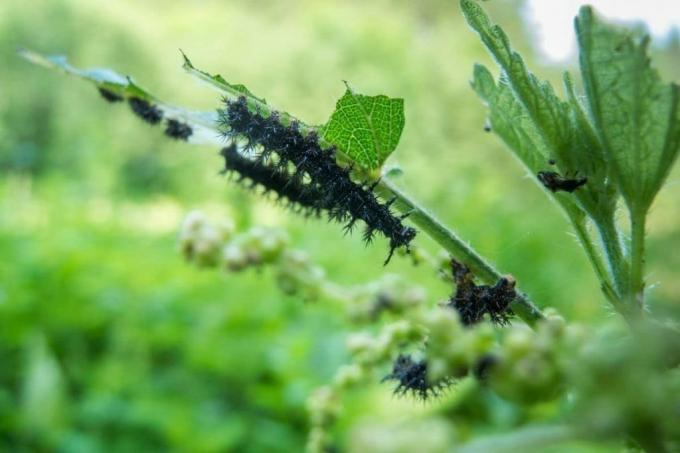
- scientific name: Araschnia levana
- Occurrence: in moist tall herbaceous areas or sparse forests
- Forage plants: nettle, common burdock chervil
- Hatching time: next year between April and June
- Generations: two every year
- Appearance: finely spotted white with interrupted yellowish-white stripes
- Size about. 25 millimeters
Note: The caterpillars on the map have tufts of thorns on each body segment. These are branched and give the larva a prickly appearance. These caterpillars are more common in August.
Peacock butterfly

- scientific name: Aglais io
- Occurrence: in open forests, parks and gardens
- Forage plants: nettle
- Hatching time: after two to three weeks
- Generations: two a year
- Appearance: black and white with fine white spots and black thorns
- Size: up to 42 millimeters
frequently asked Questions
In August there are no common caterpillars that cause health problems. The oak processionary moth, whose moths hatch in August, is feared. At this point in time, there is no longer any danger from this species. The caterpillars of the cinnamon bear ingest toxic alkaloids from their forage plants, making them inedible for predators. Since these are not on people's menus, there are no known health side effects.
Usually it is the long hair that spreads in the air and can get onto the skin and mucous membrane. Many people show allergic reactions caused by proteins. The hair of the oak processionary moth contains the protein thaumetopoein, which causes shortness of breath, itching and inflammation.
Most species pose no threat to useful or ornamental plants. Some specimens occur seasonally in large populations, so that entire plant populations can be destroyed. In the event of an infestation with several caterpillars of the willow borer, isolated trees can die. Between June and September, the generations of cabbage whites cause crop losses in cabbage cultivation. The agate owl is an occasional pest of ornamental plants such as chrysanthemums and causes damage to vines, vegetables and fruit trees.


